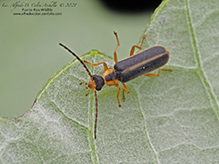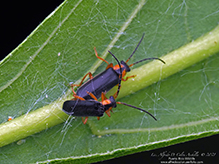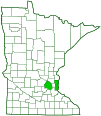gold-mouthed soldier beetle
(Rhagonycha oriflava)
Conservation • Description • Habitat • Ecology • Distribution • Taxonomy
|
|
||||||||||||||
Description |
Gold-mouthed soldier beetle is a small, short-lived, soldier beetle. It occurs in the United States from New Hampshire west to Minnesota and in eastern Texas. It also occurs in southern Ontario Canada. Adults are found on flowers and vegetation in late spring and early summer. They prey on other small insects but also take flower nectar. Little information can be found on this species beyond its original description in 1874. Adults are small, ¼″ (6.5 mm) in length, and black with yellow, orangish-yellow, or yellowish-orange markings. The body is soft and somewhat flattened. The head is mostly exposed, is not constricted behind the eyes, and is not concealed beneath the pronotum. This distinguishes all soldier beetles (family Cantharidae) from fireflies (family Lampyridae). It is black behind the eyes, yellow in front of the eyes. This is the feature that gives the species its common name and readily distinguishes it from the otherwise similar angular soldier beetle (Rhagonycha angulata) and linear soldier beetle (Rhagonycha lineola). The antennae are long, slender, thread-like, and black. They have 11 segments. The thorax is flattened but is slightly convex when viewed from the side. The exoskeletal plate covering the thorax (pronotum) is one-and-a-half times wider than long, widest at the base, and narrowed in front. The front margin is rounded and partly conceals the head, the sides are nearly straight, the rear is slightly rounded, and the angles are rounded. The margins are narrowly flattened and sharp. The upper surface is shiny and yellow, with a broad, black, longitudinal stripe in the middle. The wing covers (elytra) are black, parallel-sided, leathery, and flexible. They loosely cover the abdomen, sometimes completely, sometimes leaving the tip of the abdomen exposed. They are only slightly wider than the pronotum. The margins are narrowly flattened and pale. The inner margin (suture) is usually also pale. The surface is finely pitted (punctate) and is covered with short, fine hairs. The plate between the wing bases (scutellum) is small and black. The legs are long, slender, and mostly yellow. The third segment (femur) of each leg is dark at the base. The end part of each leg (tarsus), corresponding to the foot, has 5 segments. The fourth tarsal segment is deeply lobed and heart shaped. |
Size |
Total length: ¼″ (6.5 mm) |
Similar Species |
Habitat |
|
Ecology |
Season |
Spring and early summer |
Behavior |
Adults are active during the day. |
Life Cycle |
|
Larva Food |
|
Adult Food |
Mostly insects but also flower nectar |
Distribution |
||
|
Sources |
|
| 11/7/2024 | ||
Occurrence |
||
|
||
Taxonomy |
|
Order |
Coleoptera (Beetles) |
Suborder |
Polyphaga (Water, Rove, Scarab, Long-horned, Leaf, and Snout Beetles) |
Infraorder |
Elateriformia |
Superfamily |
Elateroidea (click, firefly and soldier beetles) |
Family |
Cantharidae (soldier beetles) |
Subfamily |
Cantharinae |
Tribe |
Cantharini |
Genus |
Rhagonycha |
This species was originally described in 1874 as Telephorus oriflavus. |
|
Subordinate Taxa |
|
|
|
Synonyms |
|
Telephorus oriflavus |
|
Common Names |
|
gold-mouthed soldier beetle |
|
Glossary
Elytra
The hardened or leathery forewings of beetles used to protect the fragile hindwings, which are used for flying. Singular: elytron.
Pronotum
The exoskeletal plate on the upper side of the first segment of the thorax of an insect.
Punctate
Dotted with pits (punctures), translucent sunken glands, or colored spots of pigment.
Scutellum
The exoskeletal plate covering the rearward (posterior) part of the middle segment of the thorax in some insects. In Coleoptera, Hemiptera, and Homoptera, the dorsal, often triangular plate behind the pronotum and between the bases of the front wings. In Diptera, the exoskeletal plate between the abdomen and the thorax.
Visitor Photos |
||
Share your photo of this insect. |
||
This button not working for you? |
||
Alfredo Colon |
||
 |
 |
|
 |
 |
|
MinnesotaSeasons.com Photos |
||
|
||
|
||

Slideshows |
|

Visitor Videos |
||
Share your video of this insect. |
||
This button not working for you? |
||
|
Other Videos |
||
|

Visitor Sightings |
||
Report a sighting of this insect. |
||
This button not working for you? |
||
Alfredo Colon |
Location: Albany, NY |
 |
Alfredo Colon |
Location: Albany, NY |
 |
| Alfredo Colon 6/2/2021 |
Location: Woodbury, Minnesota |
 |
| Alfredo Colon 5/30/2021 |
Location: Woodbury, Minnesota |
 |
MinnesotaSeasons.com Sightings |
||
|

Created: 6/21/2023 Last Updated: © MinnesotaSeasons.com. All rights reserved. |
